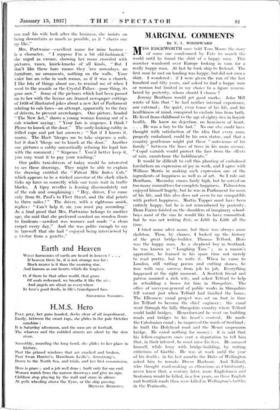MARGINAL COMMENTS
. . ply E. L. WOODWARD ISS EDGEWORTH once told Toni Moore t he story of sonic one condemned by Fate to search the world until he found the shirt of a happy man. This -searcher wandered over Europe looking in vain for a really happy man. At last he took ship to Ireland. The -first man he met on landing was happy, but did not own a shirt. I wondered : if I were given the run of the last hundred and fifty years, and asked to find a happy man or woman but limited in my choice to a figure remem- bered by posterity, whom should I choose ?
Jeremy Bentham would get good marks. John Mill wrote of him that " he had neither internal experience, nor external ; the quiet, even tenor of his life, and his healthiness of mind, conspired to exclude hint from both. He lived from childhood to the age of eighty-five in boyish health. . He knew no dejection, no heaviness of heart.
. . He was a boy to the last." No one else could have thought with satisfaction of the idea that every man, properly embalmed, could be his own statue, and that a country gentleman might put these " auto-icons of his family " between the lines of trees in his main avenue. " Copal varnish would protect the face front the effects of rain, caoutchouc the habiliments."
It would be difficult to call this planting of embalmed forefathers an expression of joy in work, and I agree with William Morris in making such expression one of the ingredients of happiness as well as of art. So I rule out Bentham. Macaulay comes fairly high, but he served on too many committees for complete happiness. Palmerston enjoyed himself hugely, but he was in Parliament for most of his life, and this also does not seem to me compatible with perfect happiness. Martin Tupper must have been entirely happy, but he is not remembered by posterity. Dean Farrer foisted on the shoulders of imaginary school- boys most of the sins he would like to have committed, but he was not writing Erie, or Little by Milk all the time.
I tried name after name, but there was always some skeleton. Then, by chance, I looked up the history of the great bridge-builder. Thomas Telford. Here was the happy man. As a shepherd boy in Scotland, he was known as " Laughing Tani " ; as a mason's apprentice, he learned in his spare time not merely to read poetry, but to write it. When he came to London, still writing poems and cutting stones, he rose with easy success front job to job. Everything happened at the right moment. A Scottish friend and patron married a rich wife, and asked Telford to help in rebuilding a house for him in Shropshire. The office of surveyor-general of public works in Shropshire fell vacant just when Telford had finished the house. The Ellesmere canal Project was set on foot in time for Telford to become the chief engineer ; the canal went through the hilly Shropshire country where Telford could build bridges. Henceforward he went on building roads and bridges to his heart's content. lie made the Caledonian canal ; he improved the roads of Scotland ; he built the Holyhead road and the Menai suspension bridge. He cared nothing for money ; it is said that his fellow-engineers once sent a deputation to tell him that, in their interest, he must raise his fees. He amused himself, while busy with bridge-building, by writing criticisms of Goethe. He was at work until the year of his death ; in his last months the Duke of Wellington asked him to remake Dover Harbour. And Telford, who thought road-making as efficacious as Christianity, never knew that, a century later, more Englishmen and Scotsmen would be killed, in a few years, on these English and Scottish roads than were killed in Wellington's battles in the Peninsula.










































 Previous page
Previous page